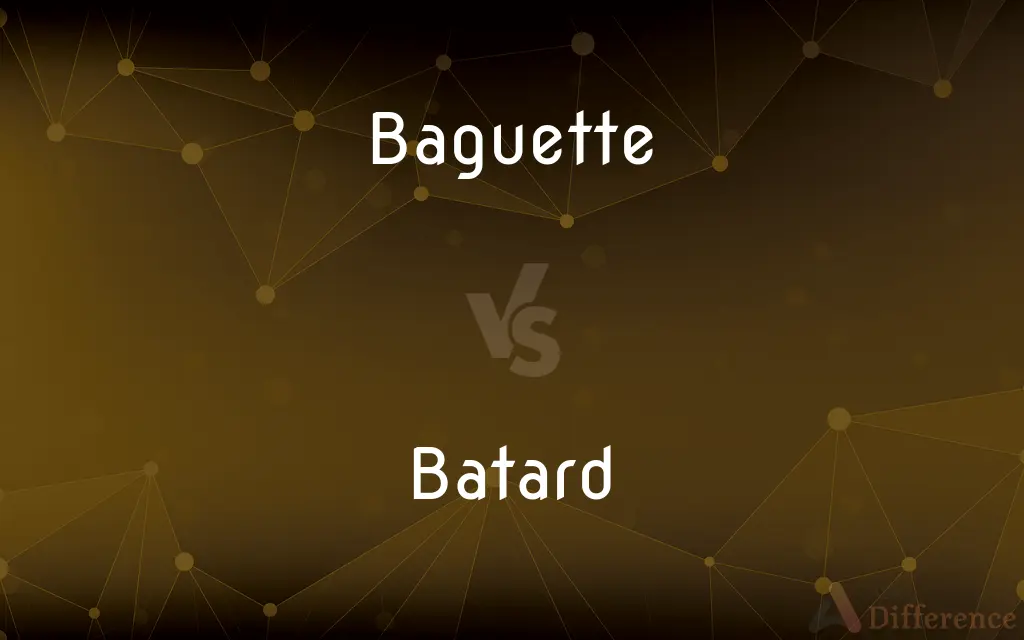Baguette vs. Batard — What's the Difference?
By Tayyaba Rehman — Updated on November 5, 2023
A baguette is a long, thin French bread with a crisp crust, while a batard is shorter, thicker, and with a softer crust.

Difference Between Baguette and Batard
Table of Contents
ADVERTISEMENT
Key Differences
The baguette is famed for its length and slender shape, a crusty exterior, and a soft, airy interior with a chewy texture. A batard, although similar in ingredients to a baguette, is shorter and plumper with a more tender crust and less crust-to-crumb ratio.
Baguettes are a symbol of French culture and are often seen extending out of shopping bags or being carried under arms. In contrast, batards are less iconic but favored for those who prefer a balance more towards the bread's interior or crumb.
A typical baguette might be about two to three feet long and two to three inches in diameter. The batard is more variable in length but is generally around half the length of a traditional baguette with a wider diameter.
The baking time and technique for a baguette require a steam-injected oven to achieve its distinctive crust, while a batard's crust is typically softer due to the shorter baking time and potentially different humidity conditions.
Comparison Chart
Shape
Long and thin
Short and thick
ADVERTISEMENT
Crust
Crisp and golden
Softer and lighter
Length
About 60-90 cm
About 30-45 cm
Diameter
5-6 cm
Wider than a baguette
Crust to Crumb Ratio
Higher
Lower
Compare with Definitions
Baguette
Long shape
The baker displayed the fresh baguettes in a tall basket.
Batard
Thicker shape
He preferred the batard for its substantial slices.
Baguette
French bread
She sliced the baguette diagonally to make crostini.
Batard
Short bread
The batard was easier to carry home than a full-length baguette.
Baguette
Crisp crust
The crunch of the baguette's crust was satisfyingly loud.
Batard
Dense crumb
The batard's dense crumb held up well to the hearty stew.
Baguette
Thin diameter
The baguette was thin enough to fit through the handle of the shopping bag.
Batard
Soft crust
The batard's softer crust was gentle on the palate.
Baguette
A baguette (; French: [baɡɛt] (listen)) is a long, thin type of bread of French origin that is commonly made from basic lean dough (the dough, though not the shape, is defined by French law). It is distinguishable by its length and crisp crust.
Batard
Wider diameter
Sandwiches made with batard had more bread in each bite.
Baguette
A long, narrow French loaf.
Batard
A loaf of bread similar in shape to a baguette, but shorter (15 to 30 cm / 6 to 12 inches in length).
Baguette
A gem, especially a diamond, cut in a long rectangular shape
A baguette diamond
Baguette
A small moulding, semicircular in section.
Baguette
A slim, rectangular handbag with a short strap.
Baguette
A long narrow loaf of French bread.
Baguette
A gem cut in the form of a narrow rectangle.
Baguette
The form of such a gem.
Baguette
(Architecture)A narrow convex molding.
Baguette
A shallow rectangular handbag.
Baguette
A narrow, relatively long rectangular shape.
Baguette
A gem cut in such a shape.
Baguette
A variety of bread that is long and narrow in shape.
Baguette
(architecture) A small molding, like the astragal, but smaller; a bead.
Baguette
(zoology) One of the minute bodies seen in the divided nucleoli of some Infusoria after conjugation.
Baguette
A French person, or a person of French descent.
Baguette
Narrow French stick loaf
Baguette
Airy interior
The baguette's airy interior was perfect for absorbing the olive oil.
Common Curiosities
Is a baguette always made from white flour?
Traditionally, yes, though variations with other flours exist.
What is a batard?
A shorter, wider loaf of French bread with a softer crust than a baguette.
What is a baguette?
A long, thin loaf of French bread with a crispy crust.
How should you store a baguette to keep it fresh?
Best eaten the same day; otherwise, store in a paper bag at room temperature.
Why is the baguette so crusty?
Steam during baking creates its signature crust.
Can you use a batard for sandwiches?
Yes, its wider slices are well-suited for sandwiches.
Does a batard have a different dough than a baguette?
No, the dough is typically the same, but the shape and baking time differ.
Is a batard more expensive than a baguette?
Not necessarily, price often depends on the bakery.
Is the batard dough fermented like baguette dough?
Yes, fermentation is key to its flavor and texture.
Are baguettes vegan?
Classic recipes are vegan, made from flour, water, yeast, and salt.
Are batards common in France?
Yes, they are a popular alternative to baguettes.
How long does it take to bake a baguette compared to a batard?
Baguettes usually bake faster due to their thinner shape; batards require more time due to their thickness.
Do baguettes contain preservatives?
Traditional baguettes do not contain preservatives.
Can you make a batard at home without a steam oven?
Yes, you can create steam with a pan of water in the oven.
What meals are batards best for?
They pair well with soups, stews, and as a base for bruschetta.
Share Your Discovery

Previous Comparison
Shod vs. Shoed
Next Comparison
Creator vs. CreatureAuthor Spotlight
Written by
Tayyaba RehmanTayyaba Rehman is a distinguished writer, currently serving as a primary contributor to askdifference.com. As a researcher in semantics and etymology, Tayyaba's passion for the complexity of languages and their distinctions has found a perfect home on the platform. Tayyaba delves into the intricacies of language, distinguishing between commonly confused words and phrases, thereby providing clarity for readers worldwide.
















































